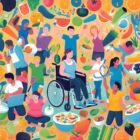11 Effective Tips for Navigating Government Food Stamps

Are you struggling to navigate the complexities of government food stamps? Look no further.
In this article, we have compiled 11 effective tips to help you successfully navigate the process. From understanding eligibility requirements to maintaining communication with your caseworker, these tips will ensure you are well-prepared and informed.
So, get ready to take control of your food stamp application and start benefiting from this valuable assistance.
Key Takeaways
- Eligibility requirements include income thresholds, residency requirements, work registration, and asset limits
- Accurate and complete submission of necessary documents is crucial for the application process
- Seek assistance from local community organizations and government offices for guidance and support
- Stay informed about income limits, report any changes promptly, and provide necessary documents for income verification
Understand Eligibility Requirements
To determine if you qualify for government food stamps, you need to meet certain eligibility requirements. These requirements are in place to ensure that the program benefits those who truly need assistance.
The first eligibility requirement is income. Your income must be below a certain threshold, which is based on the size of your household. The government takes into account your gross income, as well as any deductions or expenses you may have.
The second requirement is residency. You must be a U.S. citizen or a qualified non-citizen and reside in the state where you’re applying for food stamps. Additionally, you must provide proof of identity and your social security number.
Another important requirement is work registration. In most cases, able-bodied adults without dependents must register for work and participate in an employment and training program.
Finally, you must also meet certain asset limits. This means that your countable resources, such as cash, bank accounts, and property, must be below a certain value.
Understanding these eligibility requirements is crucial when applying for government food stamps, as it will determine if you qualify for assistance.
Gather Necessary Documents
To successfully apply for government food stamps, you need to gather the necessary documents. These documents include proof of income, identification, and residency.
It’s important to understand the document submission process and ensure that all required paperwork is provided to avoid any delays in the application process.
Required Paperwork for Eligibility
You will need to gather the necessary documents in order to be eligible for government food stamps. The required paperwork varies by state, but generally includes proof of identity, residency, income, and expenses.
To prove your identity, you may need to provide a valid driver’s license, passport, or birth certificate. Residency can be proven with a utility bill or lease agreement.
Income documentation can include pay stubs, tax returns, or a letter from your employer. You’ll also need to provide information about your expenses, such as rent or mortgage payments, utility bills, and childcare costs.
It’s important to gather all the required paperwork accurately and completely to ensure a smooth application process and to demonstrate your eligibility for government food stamps.
Document Submission Process
Gathering the necessary documents is crucial when navigating the document submission process for government food stamps. To ensure a smooth application process, it is important to have all the required paperwork ready. Here is a helpful table outlining the essential documents you may need to provide:
| Required Documents | Examples |
|---|---|
| Identification | Driver’s license, passport, or ID card |
| Proof of income | Pay stubs, tax returns, or employment letter |
| Proof of residency | Utility bills or lease agreement |
| Social Security numbers | Social Security cards or documents |
| Household expenses | Rent or mortgage statements, utility bills |
| Citizenship or immigration | Birth certificate, naturalization documents |
Complete the Application Accurately
Ensure that all required documents are submitted with your food stamps application. It’s crucial to complete the application accurately to avoid delays or potential denial of benefits. To do so, make sure to provide all the necessary information, such as your personal details, income, household size, and expenses. Double-check your application to ensure that all fields are filled out correctly and all information is up-to-date.
When completing the application, be honest and transparent about your financial situation. Include all sources of income, even if they seem insignificant. Remember to update your application if there are any changes in your circumstances, such as a job loss or increase in household size.
To avoid mistakes, carefully read the instructions provided with the application. If you have any questions or need assistance, reach out to the food stamps office or consult their website for guidance. Additionally, consider seeking assistance from community organizations or social workers who can help you navigate the application process accurately.
Seek Assistance From Local Resources
To further streamline your food stamps application process and ensure accurate completion, consider reaching out to local resources for assistance. These resources can provide valuable guidance and support throughout the application process. Here are some ways local resources can help:
- Community organizations: Local community organizations often have staff members who are knowledgeable about government assistance programs. They can help you understand the eligibility criteria, navigate the application process, and gather the necessary documentation.
- Social service agencies: Social service agencies specialize in providing assistance to individuals and families in need. They can help you determine your eligibility for food stamps, assist with completing the application, and ensure that all required information is included.
- Food banks: Food banks not only provide food assistance but also have staff who can offer guidance on accessing government benefits. They can help you understand the application process and connect you with additional resources that may be available in your community.
- Local government offices: Your local government offices, such as the Department of Social Services or the Department of Human Services, can provide information and assistance with the food stamps application. They can help you complete the application accurately, answer any questions you may have, and provide guidance on the required documentation.
Familiarize Yourself With Income Limits
To successfully navigate government food stamps, it’s crucial to familiarize yourself with the income limits. This will help you determine if you meet the eligibility requirements for assistance.
Understanding the income verification process, as well as how benefits are calculated and distributed, will ensure you have the necessary information to apply for and receive the support you need.
Eligibility and Requirements
Familiarizing yourself with the income limits is crucial when determining your eligibility and requirements for government food stamps. Here are some important points to consider:
- Income Limits: The first step is to understand the income limits set by the government. These limits vary depending on factors such as household size and location.
- Gross vs. Net Income: It’s important to differentiate between gross and net income. Gross income refers to the total income before deductions, while net income is the amount after deductions. Net income is usually considered when determining eligibility for food stamps.
- Income Sources: Take into account all sources of income, including wages, self-employment income, and any government assistance you may be receiving.
- Reporting Changes: Remember to report any changes in your income promptly. This includes changes in employment or household size.
Understanding these eligibility and requirement factors will help you navigate the government food stamp program more effectively.
Now, let’s move on to the next section about the income verification process.
Income Verification Process
You need to familiarize yourself with the income verification process to navigate government food stamps effectively. The income verification process ensures that only eligible individuals receive food stamp benefits based on their financial need. To understand the income limits set by the government, refer to the table below:
| Household Size | Maximum Monthly Income |
|---|---|
| 1 | $1,383 |
| 2 | $1,868 |
| 3 | $2,353 |
These income limits are subject to change, so it’s important to stay updated. During the income verification process, you will need to provide documents such as pay stubs, bank statements, and tax returns to prove your income. It’s crucial to accurately report your income to avoid any penalties or disqualification from receiving food stamp benefits. Understanding the income verification process will help you navigate the food stamp system smoothly and ensure you receive the assistance you need. Now let’s move on to the next section about benefits calculation and distribution.
Benefits Calculation and Distribution
Understanding the income limits is crucial for effectively navigating the government food stamp system and ensuring you receive the assistance you need. Here are four important points to keep in mind:
- Income eligibility: Familiarize yourself with the income limits set by the government. These limits vary depending on factors such as household size and location.
- Calculating income: Take into account all sources of income when determining your eligibility. This includes wages, self-employment income, and any government benefits you may receive.
- Reporting changes: It’s essential to report any changes in your income promptly. This includes increases or decreases in income, changes in employment, or any other relevant changes that may impact your eligibility for food stamps.
- Distribution of benefits: Once you qualify for food stamps, the benefits are typically distributed through an Electronic Benefit Transfer (EBT) card. Familiarize yourself with how to use the card and the authorized retailers where you can redeem your benefits.
Keep Track of Changes in Household Circumstances
To effectively navigate government food stamps, it’s crucial to regularly update and document any changes in your household circumstances. Keeping track of these changes ensures that you receive the appropriate amount of assistance and helps prevent any potential issues with your benefits. It’s important to notify the relevant authorities as soon as possible when there are modifications in your household, such as changes in income, employment status, or family size.
When it comes to changes in income, whether it’s an increase or decrease, it’s essential to report these changes promptly. This includes not only changes in employment but also any changes in government assistance or other sources of income. Failure to report accurate information can result in overpayment or underpayment of benefits, which can create additional problems down the line.
Additionally, changes in your household size, such as the birth or adoption of a child, or a family member moving in or out, should be reported promptly. These changes can affect the amount of assistance you’re eligible to receive, and failure to report them could lead to incorrect benefit calculations.
Utilize Online Resources for Updates and Information
To stay up-to-date with the latest information and updates regarding government food stamps, it’s crucial to utilize online resources.
Online platforms provide convenient access to updates and alerts, ensuring that you’re aware of any changes that may affect your eligibility or benefits.
With accessible information sources, you can easily find answers to your questions and stay informed about program requirements, saving you time and effort in the process.
Online Updates and Alerts
To stay informed about changes and updates to government food stamps, utilize online resources for timely information and alerts. Online updates and alerts can help you stay on top of any changes to the food stamps program, ensuring that you have the most up-to-date information available.
Here are some ways you can utilize online resources for updates and alerts:
- Sign up for email notifications from your state’s food stamps program website.
- Follow relevant government agencies and organizations on social media platforms such as Twitter and Facebook.
- Bookmark official websites and regularly check for any news or updates regarding food stamps.
- Subscribe to RSS feeds or newsletters from websites that provide information on government assistance programs.
Accessible Information Sources
Stay informed about updates and information regarding government food stamps by utilizing online resources.
The internet provides a wealth of accessible information sources that can help you navigate the complexities of the food stamp program.
Government websites, such as the official website of the U.S. Department of Agriculture, offer comprehensive information on eligibility requirements, application procedures, and benefit amounts.
You can also find helpful resources on state and local government websites, as well as nonprofit organizations that specialize in food assistance programs.
Additionally, consider signing up for email updates or following relevant social media accounts for the latest news and announcements.
Stay Informed, Save Time
Access the wealth of information available online to stay informed about updates and information regarding government food stamps. Utilizing online resources can save you time and provide you with the latest news and updates on food stamps. Here are four ways to make the most of these online tools:
- Visit the official government website dedicated to food stamps. It provides comprehensive information on eligibility, application process, and program updates.
- Follow government agencies and organizations on social media platforms like Twitter and Facebook. They often share important announcements and helpful resources.
- Subscribe to email newsletters from reputable organizations that focus on food assistance programs. They can provide you with regular updates and valuable insights.
- Join online forums or communities where you can connect with others who’ve experience with food stamps. You can ask questions, share tips, and learn from their experiences.
Attend Required Interviews or Appointments
Make sure you regularly attend the required interviews or appointments for your government food stamps. These interviews are an important part of the application process and are designed to ensure that you meet the eligibility criteria for receiving food assistance. Failing to attend these interviews or appointments can result in delays or even denial of your benefits.
When you receive a notice for an interview or appointment, it’s crucial that you make every effort to attend. If you’re unable to attend at the scheduled time, contact your local food stamp office as soon as possible to reschedule. It’s important to remember that missing an interview or appointment without a valid reason can negatively impact your eligibility for food stamps.
During these interviews or appointments, be prepared to provide necessary documentation and answer questions about your income, expenses, household composition, and any other relevant information. This information will help determine your eligibility and the amount of benefits you may receive.
Attending these interviews or appointments demonstrates your commitment to the program and your willingness to comply with the rules and regulations. By being proactive and responsible, you can ensure a smooth process and receive the assistance you need in a timely manner.
Familiarize Yourself With Approved Food Items
To navigate government food stamps effectively, familiarize yourself with the approved food items. Knowing what you can purchase with your benefits will help you make the most of your food stamp assistance. Here are four important categories of approved food items:
- Fruits and Vegetables: Fresh, frozen, or canned fruits and vegetables are generally approved. Look for options that are low in sodium and added sugars. Consider buying seasonal produce to save money.
- Grains: Rice, pasta, bread, and cereal are all eligible food items. Look for whole grain options to increase your fiber intake. Avoid sugary cereals or highly processed grains.
- Protein: Meat, poultry, fish, eggs, and beans are all approved sources of protein. Consider buying lean cuts of meat or opting for plant-based protein sources to stretch your food budget.
- Dairy: Milk, cheese, and yogurt are eligible dairy products. Choose low-fat or fat-free options to reduce saturated fat intake. If you’re lactose intolerant, consider lactose-free or plant-based alternatives.
Understand How Benefits Are Calculated
Understanding the calculation of benefits is crucial for effectively navigating government food stamps. The amount of benefits you receive is determined by various factors, including your income, household size, and expenses.
To calculate your benefits, the government uses a formula that takes into account your net income and deducts eligible expenses. These expenses may include rent or mortgage payments, utility bills, and medical expenses.
The remaining amount is then compared to the maximum benefit level for your household size. If your income falls below this level, you may be eligible to receive the maximum benefit amount.
It’s important to note that benefits aren’t intended to cover all of your food expenses, but rather to supplement your budget. Understanding how your benefits are calculated can help you make informed decisions about your grocery shopping and meal planning.
Now that you understand how benefits are calculated, it’s important to maintain communication with your caseworker.
Maintain Communication With Your Caseworker
Stay in regular communication with your caseworker throughout your experience with government food stamps to ensure that you’re receiving the support you need. Building and maintaining a good relationship with your caseworker can help streamline the application process and resolve any issues or concerns that may arise. Here are some tips for effectively communicating with your caseworker:
- Be proactive: Reach out to your caseworker regularly to provide updates on your situation, such as changes in income, employment, or household composition. This will help ensure that your benefits are accurately calculated and adjusted as needed.
- Ask questions: If you have any doubts or confusion about the food stamp program, don’t hesitate to ask your caseworker for clarification. They’re there to assist you and can provide valuable information regarding eligibility criteria, application process, and benefits.
- Keep records: Maintain a record of all communication with your caseworker, including dates, times, and summaries of conversations. This can be useful if any discrepancies or issues arise in the future.
- Follow up: If you have submitted any required documentation or have requested a change in your benefits, follow up with your caseworker to ensure that the necessary actions have been taken.
Frequently Asked Questions
Can I Use Food Stamps to Purchase Non-Food Items Like Toiletries or Cleaning Supplies?
Yes, you can use food stamps to purchase non-food items like toiletries or cleaning supplies. This can help you save money on essential household items while utilizing your government benefits.
Can I Apply for Food Stamps if I Am Currently Employed but Have a Low Income?
Yes, if you are currently employed but have a low income, you may still be eligible to apply for food stamps. The program is designed to assist individuals and families with limited financial resources.
What Happens if My Household Income Changes After I Have Been Approved for Food Stamps?
If your household income changes after being approved for food stamps, you should report the change to the government immediately. They will reassess your eligibility and adjust your benefits accordingly.
How Long Does It Typically Take for a Food Stamps Application to Be Processed?
It typically takes a few weeks for a food stamps application to be processed. You will receive a notice in the mail once your application has been approved or denied.
Are There Any Restrictions on Where I Can Use My Food Stamp Benefits?
You can use your food stamp benefits at most grocery stores, supermarkets, and farmers markets. Some restrictions may apply, such as not being able to use them for hot prepared foods or non-food items.



